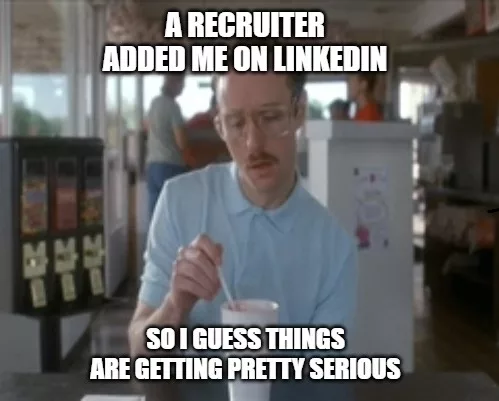
Stop applying for jobs. Let jobs apply to you. 😉
Oh boy, that title promises a lot, huh?
On average, I get around 4 to 5 jobs outreached to me each month on LinkedIn.
In fact, my current job at FATJOE came via LinkedIn (I didn’t apply).
Now, this isn’t some fluke, or luck. I have specifically optimised my LinkedIn to game the system which powers the recruitment tools.
Here’s how to do it.
Can’t be bothered to read today? I feel ya. Here’s a video version:
Is your cover photo a stock photo? Or worse, the default cover?

What a waste of valuable space!
Mine changes relatively regularly, so this will probably be out of date by the time you see it, but here’s my current one:

There are a few key things to take away here.
There are a couple of schools of thought here.
One is to keep it super short, as most people will only see your headline when it’s above one of your posts.
One is to pad it up with loads of details, as you’ve got nothing to lose and those who visit your profile will see the whole thing.
There’s a middle option.
You don’t necessarily have to keep it short, but bear in mind it will be heavily truncated on smaller screens. As such, put what you do as the first sentence.
Here’s mine:
Giving marketers confidence with actionable, straightforward advice 💪 | Head of Marketing @ FATJOE 🧠 | Ex-Agency Leader | Author & Content Creator 📖
There’s a reason this is called the “headline”. It’s the first thing people read when they visit your profile.
It’s your first opportunity to set the scene, sell your experience and put in some juicy keywords for the recruitment algorithm.
If yours is along the lines of “[Job Title] at [Company]”, you’re doing yourself a disservice.
Desperately neglected by most people, this section has a big impact on your visibility in the recruitment algorithm.
Make it real and first-person. None of that “Dav is an experienced marketer in the blah blah blah” stuff. It’s not a press release.
Here’s mine, as of the time of writing:

You can see I:
Most importantly, I stick in loads of keywords that are relevant to the jobs that interest me. For example, “digital strategies”, “digital marketers”, “marketing agencies”, “marketing team”, “marketing management”
Your “Top skills” fill out automatically based on the skills you add to your experience section and the ones you have been endorsed for by other LinkedIn members.
As far as I know, you can put as many skills as you want in your “Skills” section.
So go wild. Cover all the things you have skills in, such as “digital marketing”, “marketing strategy”, “search engine optimization”, “microsoft excel”, “canva”, “making tea”, “having sex”.
Dig deep here and think about all the stuff you know, no matter how small.
Make sure you include variations. For example, alongside “search engine optimization”, you could also have “SEO”.
This layers more keyword variations to satisfy the recruitment algorithm.
If you can get some endorsements from your friends, family and colleagues for your biggest skills, go for it!
Doesn’t do much for recruitment, but it does show that you are active and knowledgeable within your niche.
Here’s mine, as of writing:

This can help when prospective employers or recruiters come and stalk your profile.
Try sticking in stuff like your personal website, featured blogs, portfolios etc.
In my “Experience” section, I provide three things for each job I’ve had:
These sections give a really good overview of my experience in that role and make my job seem like it was actually important.
Also, it’s another great place to stick in those keywords!
Make sure you apply a few “Skills” to each of the roles in your experience section. it serves to show recruiters the main skills you used, but also helps the recruitment algorithm to understand your skillset.
All the stuff you put on your profile can ring a little hollow.
That’s why recommendations can be such an amazing addition. It’s personal social proof. Real people saying that you’re great at what you do.
As a recruiter or employer, I love to see this stuff as it tells me 2 things:
Those are both super strong signals.
So, go and ask your previous and current colleagues (senior, junior, whatever) to recommend you. Give them one first, then ask for one in return.
Give it a few days for the algorithm to do its thing, then rest assured that you’re now visible for all those jobs you want.
Keep you profile up to date. If possible, actually post on LinkedIn a couple of times a week. This’ll keep your name fresh in people’s minds.
Good luck!
If you want more killer career advice, drop your email in the box below. I only send emails when I’m sure it’s gonna give you real, actionable value – usually around once or twice a month.
Founder of Latent Clarity and author of the Clarity newsletter.
I help new and solo marketers be the best they can with practical, actionable, (and sometimes funny) advice.